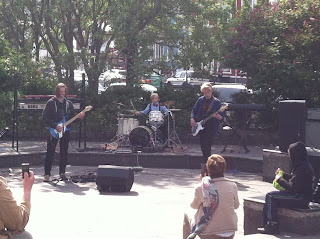Also, correction: I shared my list of Úlfar quotes with Úlfar himself, and it's actually Úlfarsfell, NOT Úlfarsvatn. Vatn means lake, Fell means mountain. Which brings me to my first lesson:
"L": L makes three sounds.
1. At the end of words, by itself, and sometimes in the middle, it is unvoiced. So shape your mouth in an "L" shape and blow. (It sounds kind of Welsh). This is also the case when words start with "hl".
2. If there are two of them, like in "fell" it is formed like the first sound in "cluck" (still unvoiced. So it is almost a click).
3. At the start of words and in some borrowed words, it's just "L"
Now you can say Eyjafjallajökull! The IslandMountainGlacier volcano that blew up and no newscasters could pronounce (look it up on youtube - it's a mess!). We all had to learn how to say it on our first day. So here it is:
You can also say "Gjörðu svo vel," which is a sort of chameleon phrase in Icelandic. It vaguely means "here you go!" or "help yourself!" but it's sometimes mistranslated as "please". IMPORTANT NOTE: THERE IS NO ICELANDIC WORD FOR PLEASE. Icelandic is not a polite language. You say "I intend to have that" because if you use the words "Can" or "May" in a store, people laugh at you.
NEXT LESSON: The unvoiced "N". This is the bane of my existence. This is contained in the word "vatn". When an n comes after a t, and in some other situations, it is unvoiced. So make the shape of an "N" with your tongue and then breathe out through your nose like a baby dragon. And somehow it's supposed to make this beautiful sound like a tiny sneeze. I just feel like I'm going to snot everywhere. I think it's supposed to sound like the noise that comes out between "mount" and "ain" for northeastern Americans (If I phonetically spell it, it's the dash in moun-n). It's pure evil.
FINAL LESSON: As promised, feminine words.
I mentioned above that borrowed words that contain "l" often pronounce it as an English "l". One example is the word "mella". When French soldiers were in Iceland, they got to know some Icelandic women quite well. When they left, they sent letters to them that had the shortened form of "Mademoiselle", "Mlle." Because of that, Icelanders started calling each recipient of those letters "mella," which of course means "whore."
Another word for "whore," "gleðikona," is a classic example of gender binary (btw, what do you call a wife in Iceland? A "gift"!). Gleði means "delight" and "kona" means woman. However, "gleðimaður," the male form, is used to refer to a guy who is the life of the party. Not. Fair.
To get the bad taste of sexism out of your mouth, here are some photos from my explorations yesterday:
This freaky waif lady is carved into the side of a statue that otherwise is completely normal. There are a bunch of angels and a knight and then HER. How did she get there?
It looks like someone left an offering for elves! (And strangely enough, it wasn't me)
Ah, so THAT's where they keep Mjölnir.
I had to take a picture of this, because the tiny tyke playing the drums has decided to completely ignore his cohorts' style choices for their soft-metal band. Just look at those suspenders and bowtie.
Til next time...




No comments:
Post a Comment